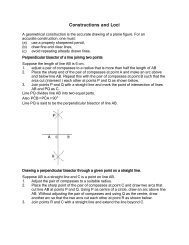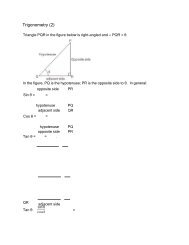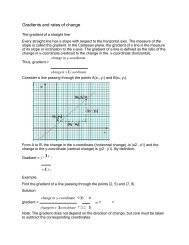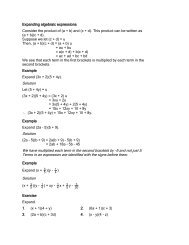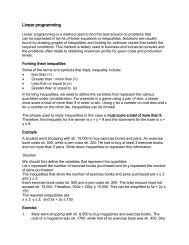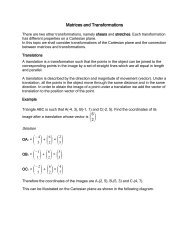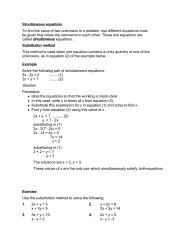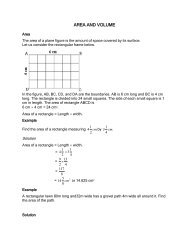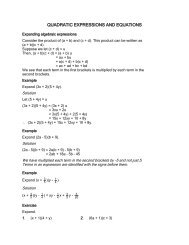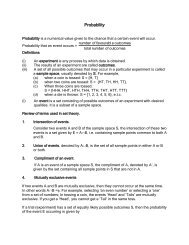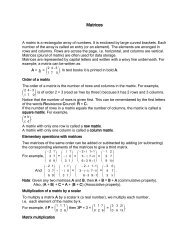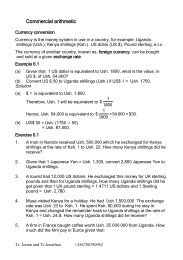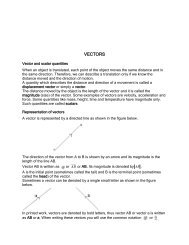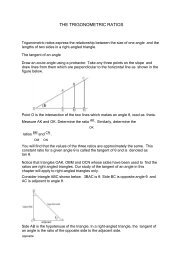J21
You also want an ePaper? Increase the reach of your titles
YUMPU automatically turns print PDFs into web optimized ePapers that Google loves.
EQUATIONS AND INEQUALITIES<br />
Equations<br />
Mathematical statements with equal signs are called equations. For<br />
instance: “I’m thinking of a number, I add 3 and multiply by 5 to get<br />
35. What is the number?”<br />
Suppose the number I thought of is x.<br />
“I add 3”: x + 3<br />
“I multiply by 5”: (x + 3) × 5 or 5(x + 3)<br />
“I get 35”: 5(x + 3) = 35.<br />
Thus 5(x + 3) = 35 is an equation. X is called the unknown. The<br />
process of finding what number x stands for is called solving the<br />
equation.<br />
What we do when we solve an equation is to find what we call a root<br />
of the equation, i.e. a value of the unknown which makes the two<br />
sides of the equation the same.<br />
With an equation we can do any of the following four things:<br />
(i)<br />
(ii)<br />
(iii)<br />
(iv)<br />
Add the same number to each side<br />
Subtract the same number from each side<br />
Multiply both sides by the same number<br />
Divide both sides by the same number.<br />
For example, the equation obtained above was<br />
5(x + 3) = 35<br />
First divide by 5: x + 3 = 35 ÷ 5<br />
x + 3 = 7<br />
Then subtract 3: x = 7 -3<br />
x = 4.<br />
So my number is 4.<br />
Check: Add 3 to 4 gives 7. Multiply 7 by 5 gives 35, so 4 is the<br />
correct number.<br />
NOTE: When solving a problem by algebra begin by taking a letter to<br />
stand for some unknown number, and state what units you are<br />
using.<br />
Example<br />
A man walks from his home to a neighboring town at 6 km per hour<br />
and then returns home by the same route at 5 km/h. He finds that the<br />
total journey takes 2 minutes longer than if he went there and back<br />
at 5 ½ km/h. Find the distance of the town from his home.
Solution<br />
Let the total distance of the town from his home be x km.<br />
The time to walk x km at 6 km/h = 6x<br />
hours.<br />
The time to walk x km at 5 km/h = 5x<br />
hours.<br />
The total time = x x<br />
) hours.<br />
(<br />
6 5<br />
The time to walk 2x km at 5 ½ km/h =<br />
x x<br />
h 4<br />
h . x x 4x<br />
1<br />
<br />
1 6<br />
<br />
5<br />
<br />
11<br />
<br />
30<br />
(Notice that every term is a number of hours)<br />
Multiply every term by 330, the L.C.M of 6, 5, 11, and 30.<br />
55x + 66x = 120x + 11<br />
121x = 120x + 11<br />
Therefore x = 11. Therefore the distance of the town is 11 km.<br />
2<br />
5<br />
2<br />
11<br />
Exercise<br />
1. I’m thinking of a number. I subtract 6 and multiply by -4. The<br />
answer is -8. What is my number?<br />
2. What is y if: (a) 3(y + 4) = 15. (b) 5(y + 3) = 55.<br />
( e 7)<br />
e 2<br />
3. Find e if: (a) 4<br />
(b) 5<br />
3<br />
4<br />
4. Find g when: (a) 3(g – 1) = 21 (b) 12(g – 6) = 108<br />
x 8<br />
5. Find the value of x when: 19<br />
2<br />
6. I think of a number and multiply it by 4; the result is the same as if<br />
I added 24 to the original number. Find the number.<br />
7. Solve the equations: (a) 29 = 7p + 8 (b) ½ x + 5 = 13<br />
(c) 5 ½ = t + 1¼.<br />
Solve the following problems by forming equations.<br />
8. The sum of the angles of a polygon of n sides is (n – 2) 180 0 . Find<br />
the number of sides if the sum is1,260 0 .<br />
9. A man, who is x years old now, has a son aged 5. In seven years<br />
the father will be 4 times as old as his son will be then. How old is<br />
the father now?<br />
10. The perimeter of a rectangle is 44 cm. If the breadth is x cm and<br />
the length (x + 2) cm, find the length and the breadth.<br />
11. A rod 30 m long is broken into two pieces, one of the length is x<br />
m and the other (x – 4) m. Find x.
12. I walked for x hours at a steady speed of 5 ½ km/h and then<br />
cycled for the same number of hours at a steady speed of 15 ½<br />
km/h. I had then traveled 49 km altogether. Find x.<br />
13. A father is 35 years old and his son is 11. In how many years<br />
will the father be twice as old as the son?<br />
14. A boy cycles from P to Q at 20 km/h and returns at 16 km/h.<br />
The total journey takes 4 ½ hours. Find the distance from P to<br />
Q.<br />
15. A boy starts out from a town A to cycle towards a town B, 90 km<br />
away at an average speed of 16 km/h. At the same moment a<br />
motorist leaves B and travels towards A at an average speed of<br />
56 km/h. After how many hours do they meet?<br />
16. A cyclist sets out along a certain road at an average speed of<br />
16 km/h. Half an hour later a motorist starts from the same<br />
place to overtake him. If the motorist’s average speed is 48<br />
km/h, find how many kilometers he must go before he<br />
overtakes the cyclist.<br />
NOTE:<br />
A term can be moved from one side of the equation to the other side,<br />
provided the sign in front of it is altered.<br />
If the equation contains brackets, these should be removed. If the<br />
equation contains fractions, multiply every term (on both sides) by<br />
the LCM of the denominators of the fractions, thus making the<br />
equation free from fractions.<br />
Example<br />
Solve the equation: 6(x + 4) – (2 – x) = 15.<br />
Removing brackets, 6x + 24 – 2 + x = 15<br />
Therefore 7x + 22 = 15<br />
7x = 15 – 22<br />
7x = -7<br />
x = -1.<br />
Example<br />
3<br />
Solve the equation: x 2( 3)<br />
x 40<br />
2 3<br />
Multiply each term by 6 (the L.C.M of 2 and 3);<br />
63x<br />
6<br />
2( x 3)<br />
24<br />
0<br />
2 3<br />
Therefore, 9x – 4(x – 3) + 24 = 0
Exercise<br />
9x -4x + 12 + 24 = 0<br />
5x + 36 = 0<br />
5x = -36<br />
x = 7 1<br />
5<br />
Solve the following equations.<br />
1. 2x + 1 = 2(2x – 3) – 3(2x – 1)<br />
2. 2(3 – 2x) – (x + 3) = 2(x + 8) + 1<br />
x 2 x<br />
1. 1<br />
2 3<br />
2. 3(x + 1) – 1 = x – 3<br />
3. 2(t – 7) = 6 + t/3<br />
4.<br />
5.<br />
6.<br />
9.<br />
1 (2z + 4) = ¼(z – 8)<br />
2<br />
y 1<br />
y <br />
2 3 5<br />
( 5x 3) (4x<br />
3)<br />
1<br />
8 5<br />
x 1<br />
x 3<br />
<br />
2 4<br />
1<br />
2<br />
10. 4(x – 5) = 10 – 2(x + 3)<br />
11.<br />
12.<br />
3x 2 3x<br />
2<br />
11<br />
<br />
2 3 4<br />
x 1 <br />
3<br />
2x<br />
3<br />
4<br />
Inequalities<br />
Statements with these signs: , ≤ or ≥ are called inequalities.<br />
< read: ‘is less than’<br />
> read: ‘is greater than’<br />
≤ read: ‘is less than or equal to’<br />
≥ read: ‘is greater than or equal to’
Example<br />
I’m thinking of a number less than seven. If I call my number w, then<br />
w < 7.<br />
This type of statement is called an inequality because the two sides<br />
are not equal. We can illustrate the inequality on a number line. 7 is<br />
not included in the set of numbers less than 7 so we put ‘ ’ above<br />
7.<br />
Example<br />
I’m thinking of a number greater than or equal to 12. If I call my<br />
number x, then x ≥ 12.<br />
On the number line: 12 is included, so we put ‘ ’ to show “or equal<br />
to 12’ The arrow shows the numbers greater than 12.<br />
Note: ‘at least 15’ means the same as ‘15 or more’ and ‘at most 15’<br />
means the same as ‘15 or less than 15’.<br />
Example<br />
Illustrate the following inequality on a number line.<br />
1 x 6<br />
Solution<br />
Exercise<br />
1. Draw a number line to illustrate the following inequalities:<br />
(a) a > 5 (b) b < 7 (c) c ≤ 7,<br />
(d) d ≥ -3.<br />
2. For each of the inequalities in question 1, write down three<br />
integers which make the inequality true.<br />
3. Write down the inequality represented by each of the number<br />
lines below:
(a)<br />
(b)<br />
(c)<br />
Solving linear inequalities<br />
The methods of solving inequalities are similar to those used in<br />
solving equations. However, the solutions for inequalities are<br />
different from those of inequalities. While an equation has a<br />
particular value as a solution, an inequality has a range of values.<br />
When solving inequalities, the following rules must be followed:<br />
(a)<br />
Addition and subtraction<br />
Any quantity can be added or subtracted on both sides of an<br />
inequality. In general, for any three numbers a, b and c,<br />
If a < b, then a + c < b + c for all c<br />
a < b, then a – c < b – c for all c<br />
a > b, then a + c > b + c for all c<br />
a > b, then a – c > b – c for all c.<br />
Note that the direction of the inequality remains unchanged.<br />
(b)<br />
Multiplication and Division<br />
The direction of the inequality is reversed if you multiply or<br />
divide by a negative number. When both sides are of a<br />
inequality are multiplied or divided by the same positive<br />
number, the inequality remains unchanged. For example, when<br />
both sides of an inequality 6 < 8 are multiplied by 3, we get<br />
18 < 24 which is true. Also dividing both sides by 2 gives 3 < 4,<br />
which is true.<br />
Thus, if a < b, then<br />
(i) ac < bc for all positive c<br />
(ii)<br />
(iii)<br />
ac > bc for all negative c<br />
a b<br />
c<br />
<br />
c<br />
for all positive c<br />
(iv)<br />
a<br />
for all negative c.<br />
c<br />
b<br />
c
Example<br />
Solve the inequality: 3x – 4 < 5.<br />
Adding 4 to both sides of the inequality, we have<br />
3x – 4 + 4 < 5 + 4<br />
3x < 9 ….dividing both sides by 3, we have<br />
x < 3.<br />
Example<br />
3<br />
Solve for x: 5<br />
2<br />
x<br />
3<br />
8<br />
x<br />
2<br />
.<br />
Multiplying both sides (each term) by 6 (the L.C.M of 2, 3)<br />
3 5x<br />
6 x<br />
6<br />
2<br />
6<br />
3<br />
68<br />
<br />
2<br />
9 – 10x> 48 + 3x<br />
Subtracting 3x from each side, we have<br />
9 – 10x – 3x > 48 + 3x – 3x<br />
9 – 13x > 48<br />
Subtracting 9 from each side, we have<br />
-13x > 39<br />
Dividing both sides by -13 (reverses the direction of the inequality).<br />
Therefore, x < -3.<br />
Example<br />
Solve the inequality 5x + 3 > -11 – 2x and represent the solution on a<br />
number line.<br />
5x + 3 > -11 – 2x<br />
7x > -14<br />
x > -2<br />
Example<br />
Find the greatest integral value of y which satisfies the inequality<br />
3y<br />
y 3.<br />
2 2<br />
Solution:<br />
3y<br />
2<br />
2<br />
y 3….multiply each term by 2<br />
4 – 3y > 2y + 6<br />
- 5y > 2 …dividing by -5
y 2<br />
5<br />
i.e. y < -0.4<br />
The greatest integral value is -1.<br />
Compound inequalities<br />
Consider the value of x such that x > 2 and x < 6. This means that x<br />
lies between 2 and 6. We can combine the two inequalities and write<br />
2 < x < 6. This is called a compound inequality.<br />
Example<br />
Find all integral values of x which satisfy<br />
7 ≥ 4 – 3x > -3.<br />
Solution:<br />
Take each inequality separately:<br />
(i) 7 ≥ 4 – 3x<br />
3x ≥ -3<br />
x ≥ -1 or -1 ≤ x<br />
(ii) 4 – 3x > -3<br />
-3x > -7<br />
Therefore x 7<br />
3<br />
Combining -1 ≤ x and 7<br />
7<br />
x<br />
3<br />
, we have -1 ≤ x < 3<br />
Integral values of x are the integer values of x. Therefore the<br />
required values of x are; -1, 0, 1, 2.<br />
Exercise<br />
Solve the following inequalities:<br />
1. 3x + 2 > -14<br />
2. x – 4 < 5x + 3<br />
3. 3x – 5 > -2<br />
4. -4x < 8 – 2x<br />
5<br />
5. 4x<br />
<br />
3<br />
2<br />
<br />
2<br />
6. x<br />
5<br />
2 <br />
x<br />
3<br />
x<br />
7. 5<br />
4<br />
6<br />
8. y 2<br />
3<br />
2<br />
y<br />
2<br />
9. 3 3<br />
4y<br />
<br />
2<br />
<br />
2<br />
2 1<br />
10. 4 x<br />
3<br />
<br />
2<br />
11. 2(x – 1) > x - 1<br />
12. 5(3 – 2x) < 3(4 – 3x).<br />
Find the solutions of the following inequalities and illustrate the<br />
solution on a number line:<br />
13. 4x + 1 > 7x – 5<br />
15. 7x – 6 ≥ 4 + 17(x – 5)<br />
14. 2(x + 3) ≥ 5(x – 4)<br />
16. -7 < 3x + 2 < x + 5
17. 8 – x < 12 ≤16 – 2x<br />
18. 11 ≤ 3x + 5 ≤ 17<br />
19. -3 ≤ -x + 2 < 0<br />
20. -2x + 1 < x – 5 < 5 – x.
Graphical representation of linear inequalities<br />
It is sometimes more useful to use x and y axes, rather than a number line. For<br />
example, to represent x ≥ 3, we draw the line x = 3.<br />
The boundary line x = 3 represents all the points for which x =3, and the region to the<br />
right contains all the points with x-coordinates greater than 3.<br />
We use a continuous line for the boundary when it is included and shade the unwanted<br />
region.<br />
In the inequality x > 3, x may not take the value 3. In this case we use a broken lie for<br />
the boundary.<br />
Graphical representation of inequalities involving two variables (x, y).<br />
Any straight line is determined by two points on it. Also any linear algebraic equation in x<br />
and y, such as 3x + 2y = 6, can be represented by a straight line graph, with the x and y<br />
axes.<br />
(i)<br />
This straight line determines the graphical<br />
representation of four linear inequalities:<br />
3x + 2y > 6, 3x + 2y 6, or 3x + 2y ≥ 6<br />
Those on the other side of the line (unshaded region), where
3x + 2y < 6 or 3x + 2y ≤ 6 as the case may be.<br />
Note: (i) You can show a particular region by shading the unwanted<br />
region.<br />
(ii) The boundary line is solid or continuous when the inequality is: ≤ or ≥;<br />
otherwise it is a dotted line i.e. when the inequality is < or > (see figures below).<br />
The following steps are taken when drawing the required region.<br />
Step 1: Write the equation of the boundary line, and find two points that lie on the line,<br />
Step 2: The sign ≥ or ≤ means that the values on given line are included. Plot the points<br />
and join them with a solid line.<br />
Step 3: To decide which side of the boundary line is the required region, take a point on<br />
either side of the line and substitute in the inequality. If the point satisfies the<br />
inequality, then it lies in the wanted region, otherwise, it is in the unwanted<br />
region.<br />
Example<br />
Show the region in which 3x + 4y < 12 by shading out the unwanted region.<br />
The boundary line is 3x + 4y = 12.
First draw this line, taking 3<br />
points on the line:<br />
x 0 2 4<br />
y 3 1.5 0<br />
On the boundary line:<br />
3x + 4y = 12;<br />
On one side of the line,<br />
3x + 4y < 12 and on the other<br />
side<br />
3x + 4y > 12.<br />
To find the required side of the line, take any point on either side of the line as a test<br />
point. If O (0, 0) is not on the boundary line, it is the simplest test point.<br />
Hence using the origin O (0, 0):<br />
3x + 4y < 12<br />
3(0) + 4(0) < 12<br />
0 < 12.<br />
Thus (0, 0) satisfies the inequality. Therefore, (0, 0) lies in the required region. Hence<br />
we shade the other side of the line. (The shaded region represents 3x + 4y > 12).<br />
Graphical solution of simultaneous linear inequalities.<br />
When the inequalities are drawn on a graph paper, the unshaded region R contains the<br />
points (x, y) which satisfy all the inequalities (constraints) given in a question. The set of<br />
points (x, y) in the region R are called the solutions of the simultaneous linear<br />
inequalities. In most solutions the x and y values taken are integers (whole numbers). In<br />
this case the solution, i.e. the set of points<br />
(x, y) where x and y are integers is called an integral solution.<br />
Example<br />
Find the region of the Cartesian plane which contains points whose coordinates satisfy<br />
the following inequalities: x ≤ 4; 2y + x ≥ 4 and<br />
4y – 3x ≤ 8.<br />
Find the integral solution of the simultaneous linear inequalities.<br />
The solutions are:
(4,0), (4,1), (4,2), (4,3), (4,4), (4,5), (3,1), (3,2), (3,3), (3,4), (2,1), (2,2), (2,3), (1,2) and<br />
(0,2).<br />
Exercise<br />
Draw graphs to illustrate the following linear inequalities on Cartesian plane.<br />
1. x < 2 2. y < -2 3. x ≤ 0 4. y > 0 5. x + y < 2<br />
6. x + y ≥ 2 7. 3x – y ≥ 0 8. x – y < 2.<br />
Show on a graph the region defined by the inequalities and hence write down the<br />
integral solution set.<br />
9. y < x, 5y > x, x + y ≤ 6<br />
10. y ≤ x + 1, x ≤ 0, y + 2 > 0<br />
2. x ≥ 0, y > 0, x + y < 3<br />
3. x ≥ 4, y ≥ 3, x +y < 13, 6x + 5y ≥ 60<br />
4. Shade, on a graph paper, the region R in which the following inequalities are<br />
simultaneously satisfied: x ≥ 2, y ≥ 0,<br />
3x + 4y ≤ 24, 3x + 4y ≥ 12.<br />
Interpretation of regions<br />
So far, we have been shading graphs to indicate the required regions defined by given<br />
inequalities. We can also define a required region already shown on a graph. We<br />
proceed as follows:<br />
Step 1: Determine the equations of the boundary lines, if these have not been given on<br />
the graph.<br />
Step 2:Choose a point in the required region and substitute in the equation of each line<br />
to determine the inequality.<br />
Step 3:Check whether the boundary line is continuous or broken. If it is continuous, use<br />
≤ or ≥ as appropriate. If it is broken, use < or > as appropriate.
Note: Describe the required region completely. All the boundaries should be included.<br />
Example<br />
Find the inequality that defines the unshaded region in the figure below.<br />
Solution<br />
Using the intercepts (-3, 0) and (0, 3), the gradient of the boundary<br />
line is<br />
30<br />
0(<br />
3)<br />
= 3<br />
3 = 1.<br />
Let (x, y) be any other point on the line, then<br />
y 0 1<br />
x ( 3)<br />
y = x + 3 is the equation of the boundary line.<br />
The boundary line is continuous so it is included in the unshaded<br />
region. The point (0, 0) is in the required region.<br />
At (0, 0), y = 0 and x + 3 = 0 + 3 = 3.<br />
But, 0 < 3. So, the inequality is y ≤ x + 3.<br />
Example<br />
Give the inequalities that define the unshaded region shown below.
Solution<br />
y = 0 is a boundary line and therefore, y ≥ 0 is one of the inequalities. The boundary line<br />
7<br />
passing through (0, 7) and (10, 0) is given by y = 7 - x or 10y + 7x = 70.<br />
10<br />
Point (4, 3) is in the required region. If x = 4 and y = 3, 10y + 7x = 58, but<br />
58 < 70. Therefore, 10y + 7x ≤ 70 is another inequality.<br />
The boundary line passing through (0, 3) and (4, 6) is given by<br />
4y – 3x = 12.<br />
Testing point (4, 3), when x = 4 and y = 3, 4x – 3y = 0 which is less than 12. The<br />
unshaded region is defined by y ≥ 0, 10y + 7x ≤ 70 and 4y – 3x ≤ 12.<br />
Exercise<br />
1. Give the inequalities that define the unshaded region R in each of the following.<br />
(a)<br />
(b)
(c)<br />
2. Give the points whose coordinates are integers and lie in the unshaded region.
3. Draw a graph and give the integral coordinates of the points that lie in the region<br />
defined by the inequalities:<br />
y > x – 2, 2y < 3x + 6, x + y > -2 and x + y 3<br />
4. The graph below shows regions A to F enclosed by lines<br />
1 5<br />
x + y = 4, y = x and y = x 4 .<br />
3 3<br />
Use inequalities to describe region: (a) A (b) B (c) C (d) D (e) E (f) F



